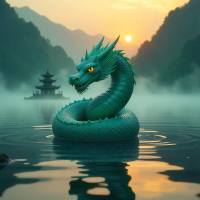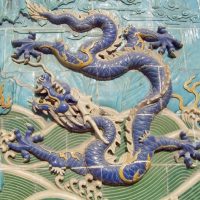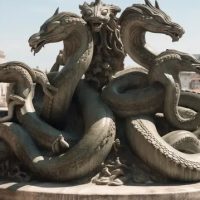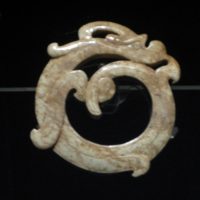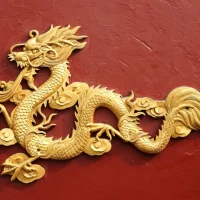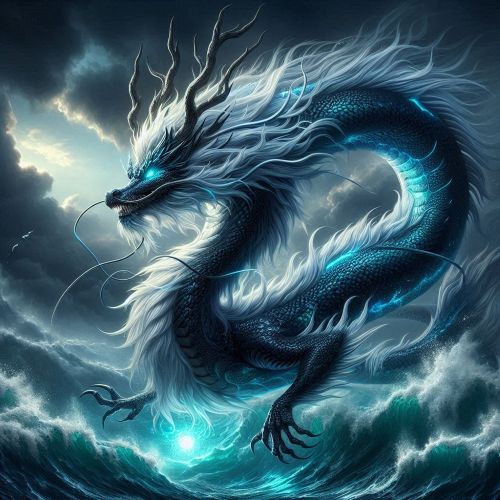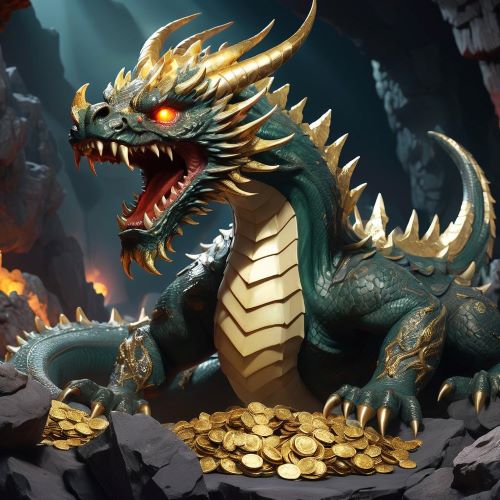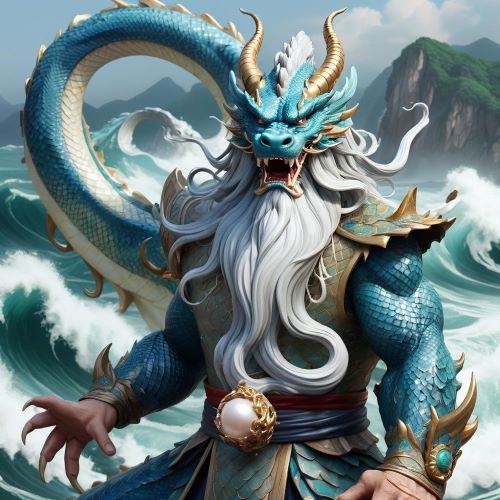Panlong : The Coiling Dragon of Chinese Mythology
Listen
At a glance
| Description | |
|---|---|
| Origin | Chinese Mythology |
| Classification | Animals |
| Family Members | N/A |
| Region | China |
| Associated With | Water, Rivers, Lakes |
Panlong
Introduction
In the boundless world of Chinese mythology, dragons are revered as divine beings that embody strength, wisdom, and balance. Among these legendary creatures, Panlong (蟠龙)—the Coiling Dragon—holds a special place. Unlike celestial dragons that soar through the skies, Panlong dwells within rivers, lakes, and underground springs, representing the unseen currents of power and life beneath the earth’s surface. Its name itself—derived from “pan” (coiled) and “long” (dragon)—captures its nature as a being of latent energy and transformation. Ancient Chinese art and literature often portray Panlong entwined around pillars, artifacts, or mountains, signifying the restrained might that guards sacred and imperial spaces.
Physical Traits
The Panlong is a majestic aquatic dragon known for its long, serpentine body and intricate coils. It is often depicted wrapped around columns, jade discs, or mountain peaks, symbolizing strength contained within harmony. Unlike Western dragons that rely on wings for flight, Panlong’s movement is fluid and mystical—capable of gliding through air and water alike, powered by inner energy rather than physical form. Its appearance mirrors that of the Jiaolong (蛟龙), or river dragon, with crocodilian features and shimmering scales that reflect the element of water. Its eyes glow like pearls of wisdom, and its beard and claws mark its divine status. Artists have long used the image of the coiled dragon to represent both physical and spiritual balance—a creature of both grace and immense, restrained power.
Family
While not as explicitly defined as the Dragon Kings (Longwang) or Celestial Dragons (Tianlong), the Panlong exists within the wider mythological family of Chinese dragons that govern various realms of existence. It shares traits with the Dilong (Earth Dragon), who oversees rivers and subterranean waters, and the Shenlong (Spiritual Dragon), who controls wind and rain. In some accounts, Panlong is mentioned as the father of Jinxuan, a mythical figure associated with wisdom and transformation. Within Daoist thought, all dragons are interconnected expressions of cosmic energy—Panlong’s domain simply lies in the depths, representing potential yet to be fully awakened.
Other names
The name Panlong (蟠龙 or 盘龙) literally translates to “Coiling Dragon.” A literary inversion of the name, Longpan (龙蟠), appears frequently in Chinese classical writings as a metaphor for hidden talent or greatness waiting to be revealed. To call someone a “Longpan” was to recognize potential lying dormant—just as the Panlong coils quietly beneath the surface, awaiting its moment to ascend. In some regional folklore, Panlong is also equated with the Jiaolong, or river dragon, emphasizing its dominion over inland waters rather than the vast seas. It is sometimes referred to as a Flood Dragon, embodying the dual nature of water as both nurturing and destructive.
Powers and Abilities
The Panlong’s powers are deeply tied to its elemental and spiritual connection with water. As a guardian of lakes, rivers, and subterranean streams, it commands rainfall and influences natural water flow—making it vital to the prosperity of ancient agricultural communities. In temple rituals, the Panlong was invoked to bring rain or halt storms, symbolizing harmony between nature and humankind.
Its coiled form represents latent strength and readiness—a dragon that holds back its might until the right moment, embodying the Daoist principle of controlled potential. Legends also credit Panlong with the ability to manipulate time and thunder, as striking the coiling dragon was said to create thunderclaps that echoed across valleys.
Spiritually, Panlong acts as a protector—guarding treasures, imperial relics, and sacred spaces. It channels qi (energy) through its coiled body, maintaining equilibrium between heaven, earth, and the underworld. In many temple carvings, the Panlong appears coiled around columns, not merely as decoration but as a symbol of protection and divine stability, keeping evil forces at bay.
Modern Day Influence
Even today, the Panlong continues to inspire art, architecture, literature, and modern symbolism. The coiling dragon motif remains one of the most enduring designs in Chinese craftsmanship, adorning jade carvings, imperial seals, and temple pillars. Its presence in feng shui represents the circulation of positive energy and protection against misfortune.
The Royal Canadian Mint’s commemorative gold and silver coins featuring Panlong demonstrate its continuing cultural resonance as a symbol of prosperity, strength, and water’s life-giving essence. In literature and pop culture, the dragon found new life through the popular Chinese fantasy novel Coiling Dragon (盘龙) by I Eat Tomatoes, where the mythic creature symbolizes inner potential and transformation.
Panlong’s imagery also influences martial arts philosophies, particularly in Tai Chi and Qigong, where coiling movements represent the flow of internal energy and balance. Urban landscapes in China further celebrate this heritage, with regions such as Panlong District in Kunming named after the legendary dragon, reflecting its enduring reputation as a protector of life and abundance.
In the modern world, the Panlong embodies both ancient wisdom and contemporary aspirations—a timeless guardian whose coiled energy mirrors humanity’s own pursuit of enlightenment and harmony with nature.
Related Images
Source
Britannica. (1998). Long | Folklore, Legends & Myths. Britannica. https://www.britannica.com/topic/long-Chinese-mythology
Wikipedia contributors. (2025). Panlong (mythology). Wikipedia. https://en.wikipedia.org/wiki/Panlong_(mythology)
Research Starters. (2021). Chinese mythology. EBSCO. https://ebsco.com/chinese-mythology
Ecumenical Buddhism. (2010). Lóng, the Chinese Dragon. https://ecumenicalbuddhism.blogspot.com/2010/10/
Royal Canadian Mint. (2024). The Coiled Dragon: Unraveling the details and symbolism of Panlong. Mint.ca. https://mint.ca/
Wang, Z. (1592). Wu Za Zu (五雜俎). Song Dynasty literary collection.
Yang, X. (18 CE). Fangyan (Regional Speech) dictionary. Ancient Chinese linguistic work.
Ouyang, X. (7th century). Yiwen Leiju (Classified Anthology of Literary Works). Ancient Chinese encyclopedia.
Schafer, E. H. (1963). The Golden Peaches of Samarkand: A Study of T’ang Exotics. University of California Press.
Lagerwey, J. (2010). Daoism and Local Cults in Early Medieval China. Harvard University Asia Center.
Frequently Asked Questions
What is Panlong in Chinese mythology?
Panlong is a coiling water dragon from Chinese mythology, known for dwelling in lakes and rivers and symbolizing hidden strength, balance, and potential.
Is Panlong different from other Chinese dragons?
Yes. While celestial dragons ascend to the skies, Panlong remains bound to freshwater and subterranean domains, representing dormant power and earthly guardianship.
What powers is Panlong believed to have?
Panlong controls rain, water currents, and weather patterns. It also serves as a spiritual guardian of temples, treasures, and balance in nature.
What does the name Panlong mean?
“Panlong” translates to “Coiling Dragon,” referring to its iconic curled posture and metaphorical meaning of latent energy awaiting awakening.
How is Panlong represented in modern culture?
Today, Panlong appears in art, literature, feng shui design, and even in numismatics, representing protection, prosperity, and the strength of untapped potential.


